
Station Name: SHIPSTON ON STOUR[Source: Darren Kitson]
Shipston-on-Stour Station: Gallery 1
Early 20th century - 1950s stour_old15.jpg) A view from the Edwardian era depicts Armstrong 1901 Class 0-6-0ST (Saddle Tank) No. 1938 awaiting departure. The train formation is a horse box, a passenger Brake carriage and some goods wagons. A single passenger carriage was usually adequate. While business appears to have been brisk, not all the people on the platform would be boarding the train as it was the custom at the time to meet people arriving and to 'see them off' on their departure. The bench on the left is of the type usually found in waiting rooms or some other under cover location. Note the tree stump utilised as, presumably, a planter. The gas lights have vertical burners with mantles either of the Lewis or Welsbach type. Locomotive No.1938 was built at Stafford Road (Wolverhampton) Works in 1886 and like many GWR Saddle Tank locomotives was converted to Pannier Tank form in 1921. It was to survive only until July 1936. When photographed she may have been the regular branch locomotive, shedded at Shipston-on-Stour.
Copyright photo from John Alsop collection 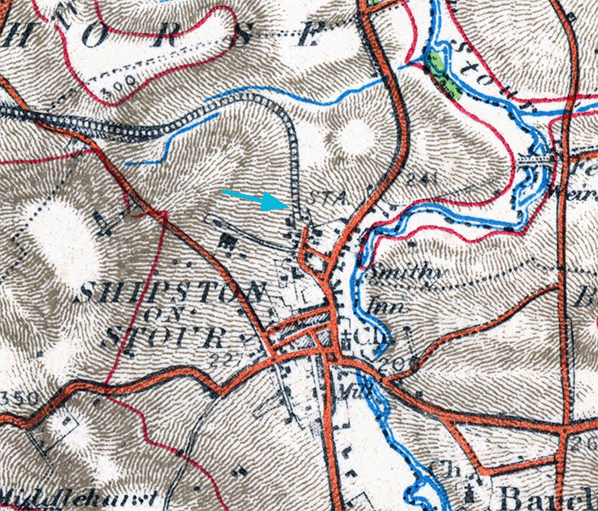 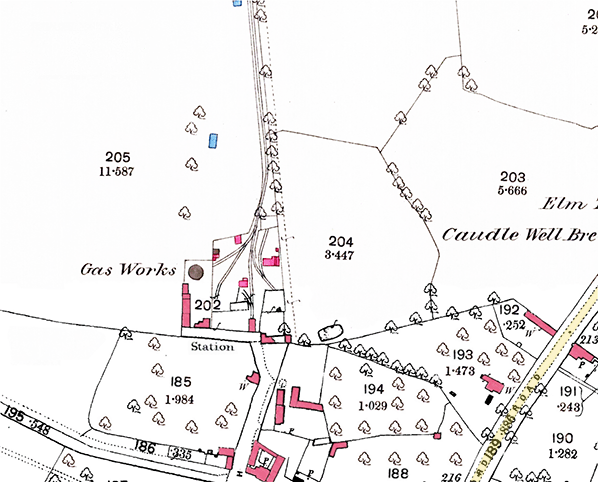
The horse tramway terminus as shown on the 1876 1:2,500 OS map. Maps are the only records available concerning Shipston-on-Stour in tramway days and it is not known what purpose the various buildings dotted around the site were. It is however safe to deduce some would have been used by coal and stone merchants and there was probably also a stable. The track layout was alright for horse-drawn wagons, note there are two sidings accessible only be means of a reversal, but totally unsuitable for locomotive operation which would come thirteen years later. At this time the gasworks had just one gasometer. Note the ruralness of the scene compared to today with much of the area shown on this map now covered by housing. Click here for a larger version.
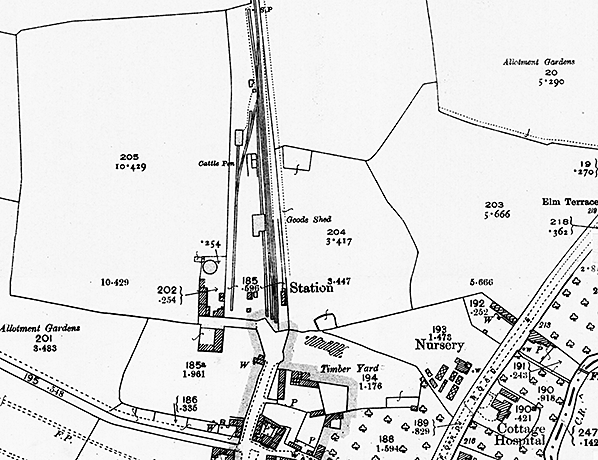
The 1902 1:2,500 OS map reveals big changes had taken place with conversion to a proper railway. Subsequently only minor changes were to occur and in particular in connection with the provision of a horse landing opposite the station building. At the top pf the map can be seen the Shipston-on-Stour Home signal (S.P). This was operated by a lever located at the south end of the station platform and was reputedly ignored much of the time, which given the branch was operated 'one engine in steam' would not have been a major issue even if it did contravene the Rule Book. In any event, drivers would have approached the terminus with caution as there was a falling gradient but with no requirement to stop and pin down brakes. The gasworks still has only one gasometer but the small buildings to the north of the manager's house (the building in the bottom right corner) have now appeared. Click here for a larger version
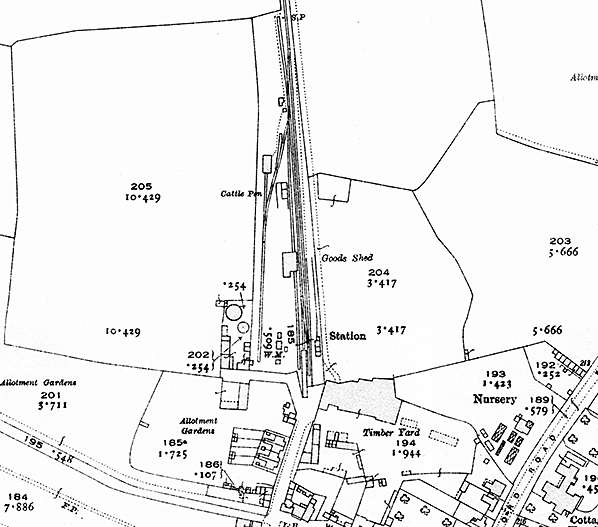 The 1932 1:2,500 OS map shows the horse landing has appeared, at the very bottom. This involved the shortening of one of the sidings and a minor alteration to the road layout just outside the station. Quiet how often the horse landing was used for its intended purpose is a matter of conjecture. There may have been a demand or the GWR could have provided it in the hope of attracting business. Certainly in later years it had fallen into disuse and the siding on its west side frequently had goods vans parked on it. Only one photograph has come to light showing the Shipston-on-Stour branch train conveying a horse box and that predates this map by many years. By the time of this map the branch passenger service had of course ceased to operate. The weighing machine (W.M.) is now shown and the gasworks has gained its second gasometer. Click here for a larger version

The Great Western Railway and BR(W) used a colour code system for what is today usually known as RA (Route Availability). It indicated maximum permissible axle load, which is a different thing to total locomotive weight, as determined by the Civil Engineer. Locomotives carried a corresponding coloured circle on their cab sides to indicate their axle loading although some, such as the 4800/1400 0-4-2Ts, were 'uncoloured' which meant they could operate over any of the company's lines. Routes coloured red could handle locomotives of up to 20 tons axle weight but broken red, such as that branching off at Kingham (part of the so-called Banbury & Cheltenham Direct Railway) indicated a speed restriction for red coded locomotives. There was also a 'double red' code which most notably applied to the 6000 (King) Class locomotives. This extract from a much larger map shows that the Shipston-on-Stour branch was coded yellow which indicated a maximum axle load of 16 tons. Yellow coded branch lines were common and another can be seen towards bottom right, the Blenheim & Woodstock branch. In due course British Railways adopted a system which had been devised by the LNER, the aforementioned 'RA' system; RA0 (lightest)
up to RA10 (heaviest). stour_old6.jpg)
Another early view, perhaps also from the Edwardian period. It is certainly pre 1914 as the horse landing has yet to be built; this was to be where the bufferstop is on the right and served by the same, albeit accordingly shortened siding. An unidentified 0-6-0ST has arrived with a Brake Composite carriage. At this time there were four trains per day on weekdays only, of which two were Parliamentary (shown in contemporary timetables as 'Gov.'). During this period locomotives could arrive at Shipston smokebox-first or bunker-first but subsequently it became the norm for locomotives to arrive at Shipston bunker or tender-first. The horse drawn vehicle on the platform is unidentified and the writing on its side is unreadable. Perhaps it connected the station with a hotel in the town, this practice being once very common. However, the GWR had some small omnibuses very similar to this and with the company name in full on the sides but no record has been found of the GWR operating such a horse drawn service at Shipston. Apart from the driver of the horse drawn vehicle all persons present, insofar as can be seen in this rather poor photograph, appear to be railway staff..
Photo from John Mann collection stour_old24.jpg)
A dray of Hutchings & Co. photographed, at a guess, sometime in the late 19th to early 20th century. The location is unknown although it will be somewhere in the Shipston-on-Stour area. Hutchings operated from the goods yard at Shipston station and may or may not have been the same Hutchings who operated from Newbold Wharf. The name ‘Hutchings’ was and is quite common in this part of the country. The driver appears to be wearing a leather apron as was normal for delivery drivers of the time.
Photo from John Mann collection stour_old3.jpg) An apparently deserted Shipston station in April 1934. The station appears for all intents and purposes to be still open to passengers but there are clues to this not being the case; the platform bench seat has vanished and the lantern beneath the canopy is minus its burner. Of the three posters, the larger two are headed ‘Great Western Railway’ and the smaller one ‘Public Notice’. Nothing else is readable although the Public Notice appears to have a timetable, omnibus perhaps, at the bottom so it may have been a notice of withdrawal of railway passenger services which had lingered since 1929. The point rodding leads from the ground frame hidden behind the buffer stop, behind the camera. The horse landing, left, still had a gate and at least some of its fencing at this time.
Copyright photo from John Alsop collection 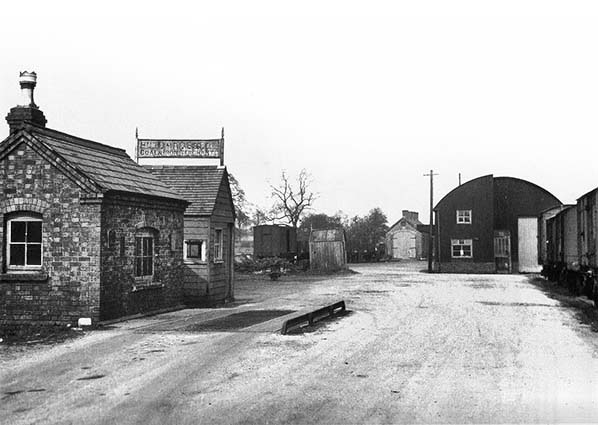 Photographs of Shipston-on-Stour station taken from the early 20th century up until the 1950s are not common but this one is believed to date from circa 1930. Directly ahead is the goods shed with the engine shed to its left and beyond. The purpose of the small hut is not known. At left foreground is Hutchings coal office, the weighbridge and weighhouse, the latter building being the only former railway structure to survive at Shipston-on-Stour today. There was another coal office out of view to the left. This view faces north and the passenger station is out of view to the right, behind the wagons. At around this time, after withdrawal of passenger services, Shipston-on-Stour had just four members of staff; Stationmaster Jack Bourne, a goods checker, a porter and a clerk. Mr Bourne, with his office in the goods shed annex, was also responsible for the stations at Longdon Road and Stretton-on-Fosse until these closed to all traffic in 1941.
Photo from John Mann collection stour_old1.jpg)
This photograph dates from April 1933 and is facing south with the station in the left background. Of interest are the inside-keyed rails. Usually bullhead rail has its keys on the outside which necessitated the linesman, during his routine track inspection walk, to check one rail and then walk back to check the other or constantly zigzag between the two rails. Inside-keyed rail allowed the linesman to check both rails as he went along. Inside-keyed rail was once quite common and well into British Railways days on minor branch lines and in sidings. Note the safety barrier outside the permanent way hut and the point rodding on the right; this latter was operated by a ground frame. The track branching off the right was a short headshunt and it was here where the crew of a Dean Goods failed to notice which track their locomotive was on and crashed through the buffer stop. Out of view to the right but further back was a Stop Board instructing crews to stop and await instructions from station staff before proceeding. The gradients on the approach to Shipston-on Stour were 1:81, 1:124, 1:70 and 1:119 at the station platform, all falling. In this photograph the camera was looking down the 1:70 section.
Photo
from John Mann collection
stour_old11.jpg)
This is one the those photographs which raises more questions than it gives answers when examined in detail. Goods traffic appears brisk and present is an LMS open wagon which tells us the date is after 1923. On the platform the running-in board has gone (it stood between the building and the lamp further along the platform) yet lighting, posters and the wheelbarrow are still present suggesting not too long after closure to passengers. We are therefore probably looking at the early 1930s. The posterboard on the end wall bears the somewhat faded heading "GREAT WESTERN RAILWAY" but unfortunately none of the posters are readable. That on the left, however, appears to be advertising a long distance train and has a look of LMS about it; it was nothing unusual for one railway company to advertise a service or services of another providing it was not promoting direct competition. On the left the dock, largely hidden by the bufferstop, still has some fencing present. By the 1950s the fencing had gone and the dock had become quite overgrown.
Photo from John Mann collection stour_old9.jpg) A presumed wintery view, going by the bare trees. This is looking south-east across the station sometime during the 1950s. Compared to the 'Levens Stone' views, only one of the 'Iron Mink' vans, that with a wooden board leaning against it, is present. On the left, the building with the chimney has either been fire damaged or is being demolished - perhaps both. A presumed wintery view, going by the bare trees. This is looking south-east across the station sometime during the 1950s. Compared to the 'Levens Stone' views, only one of the 'Iron Mink' vans, that with a wooden board leaning against it, is present. On the left, the building with the chimney has either been fire damaged or is being demolished - perhaps both.Photo from John Mann collection
|
 Notes: Shipston-on-Stour is a small delightful market town in south Warwickshire and until 1931 was situated in an exclave of Worcestershire. It is on what is now the A3400 road, formerly the A34, the change occurring in 1991 when the A34 Winchester - Manchester (Salford) road was rerouted between Chipping Norton and Solihull. ‘Shipston-on-Stour’ reputedly means ‘The town on the River Stour where sheep are washed’; a medieval description which indicated a connection with the wool trade. In reality, it would seem that sheep were merely driven through the town on their way to the sheep wash located at Sutton-under-Brailes, some three miles to the south-east. ‘Driven’ in this context means sheep travelled on foot under the control of drovers.
Notes: Shipston-on-Stour is a small delightful market town in south Warwickshire and until 1931 was situated in an exclave of Worcestershire. It is on what is now the A3400 road, formerly the A34, the change occurring in 1991 when the A34 Winchester - Manchester (Salford) road was rerouted between Chipping Norton and Solihull. ‘Shipston-on-Stour’ reputedly means ‘The town on the River Stour where sheep are washed’; a medieval description which indicated a connection with the wool trade. In reality, it would seem that sheep were merely driven through the town on their way to the sheep wash located at Sutton-under-Brailes, some three miles to the south-east. ‘Driven’ in this context means sheep travelled on foot under the control of drovers.

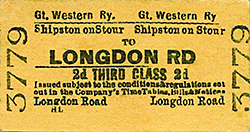 The railway to Shipston-on-Stour followed the course of the former Stratford and Moreton Railway link (the horse tramway), east from Longdon Road, including the curve southwards to arrive at the terminus situated at the north end of the town. The station was reasonably conveniently sited about 500 yards north of the town centre and adjacent to the town's gasworks. In tramway days the Shipston terminus comprised a number of sidings splayed out in various directions. Two of the sidings approached the gasworks, though neither, in tramway nor railway days, ever penetrated into the gasworks. While this arrangement of sidings would have been alright for the tramway's horse-drawn wagons it was totally impractical for the post 1889 locomotive-worked railway, therefore the station area was completely redesigned.
The railway to Shipston-on-Stour followed the course of the former Stratford and Moreton Railway link (the horse tramway), east from Longdon Road, including the curve southwards to arrive at the terminus situated at the north end of the town. The station was reasonably conveniently sited about 500 yards north of the town centre and adjacent to the town's gasworks. In tramway days the Shipston terminus comprised a number of sidings splayed out in various directions. Two of the sidings approached the gasworks, though neither, in tramway nor railway days, ever penetrated into the gasworks. While this arrangement of sidings would have been alright for the tramway's horse-drawn wagons it was totally impractical for the post 1889 locomotive-worked railway, therefore the station area was completely redesigned.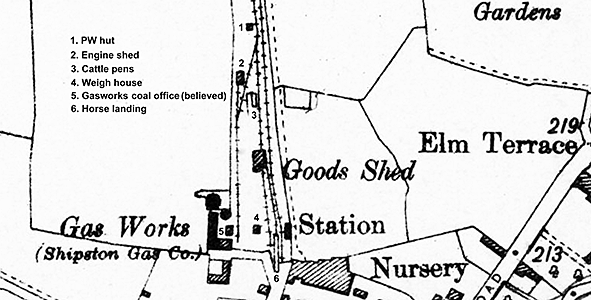
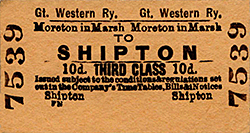 As indicated, the above map is a 1921 revision of an earlier map, perhaps surveyed in 1919. These 6 inch maps are not ideal for showing the finer details but this example adequately shows the track layout as installed by the Great Western Railway. Annotation has been added to indicate the purpose of buildings not marked by the Ordnance Survey. Between 1. and 2., was at one point in time a 'parachute' water tower for locomotive replenishment. This tank was supplied from two wells which in the event proved wholly unreliable.
As indicated, the above map is a 1921 revision of an earlier map, perhaps surveyed in 1919. These 6 inch maps are not ideal for showing the finer details but this example adequately shows the track layout as installed by the Great Western Railway. Annotation has been added to indicate the purpose of buildings not marked by the Ordnance Survey. Between 1. and 2., was at one point in time a 'parachute' water tower for locomotive replenishment. This tank was supplied from two wells which in the event proved wholly unreliable.  The solution was to bring in water by means of tank wagons, discharge the wagons into the wells then pump the water into the water tower; how the water was pumped is not known. This arrangement of bringing in water via tank wagons ceased, presumably when Shipston engine shed closed in November 1916. Locomotives thereafter took on water at Moreton-in-Marsh. The map shows track still connected to the engine shed; this was later lifted and the shed used, for a time, as a garage for a GWR motor lorry. At some point in time a coal office was also provided adjacent to 4. At the bottom of the station, site 6. was a horse landing provided sometime around 1914. Anecdotal evidence suggests this landing (actually just a ramp) was rarely used for its intended purpose, if indeed it ever was. Building 5 is curious. As indicated, it is thought to have been a coal office for the gasworks but could also have been a weigh house as it seems unlikely that the weigh house at 4 would have been used for incoming coal for the gasworks given the track layout.
The solution was to bring in water by means of tank wagons, discharge the wagons into the wells then pump the water into the water tower; how the water was pumped is not known. This arrangement of bringing in water via tank wagons ceased, presumably when Shipston engine shed closed in November 1916. Locomotives thereafter took on water at Moreton-in-Marsh. The map shows track still connected to the engine shed; this was later lifted and the shed used, for a time, as a garage for a GWR motor lorry. At some point in time a coal office was also provided adjacent to 4. At the bottom of the station, site 6. was a horse landing provided sometime around 1914. Anecdotal evidence suggests this landing (actually just a ramp) was rarely used for its intended purpose, if indeed it ever was. Building 5 is curious. As indicated, it is thought to have been a coal office for the gasworks but could also have been a weigh house as it seems unlikely that the weigh house at 4 would have been used for incoming coal for the gasworks given the track layout. 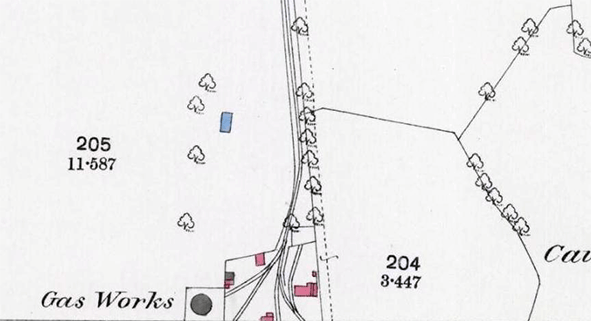
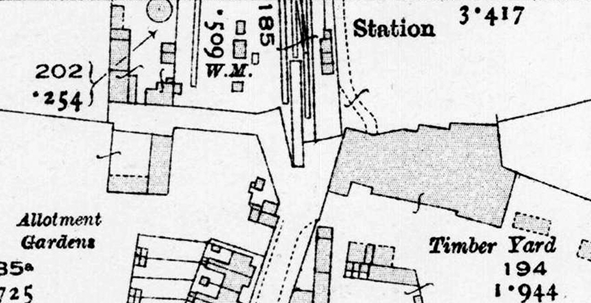 Although the terminus of the railway was on broadly the same site as that of the former horse tramway, there was a major difference in that the horse tramway veered south south-west on its approach to the terminus. Comparison is offered by this unified map, both parts being OS 25 inch, with an 1885 survey above and a 1921 revision below. Quite why it was necessary for the horse tramway to veer south south-west is unclear. It may have been to avoid structures that may have existed pre tramway. Whatever the reason, it is certainly clear that the tramway track layout was totally unsuitable for replication for a locomotive-operated1895 1:10560 (6") OS map showing Simonstone and the railway.
Although the terminus of the railway was on broadly the same site as that of the former horse tramway, there was a major difference in that the horse tramway veered south south-west on its approach to the terminus. Comparison is offered by this unified map, both parts being OS 25 inch, with an 1885 survey above and a 1921 revision below. Quite why it was necessary for the horse tramway to veer south south-west is unclear. It may have been to avoid structures that may have existed pre tramway. Whatever the reason, it is certainly clear that the tramway track layout was totally unsuitable for replication for a locomotive-operated1895 1:10560 (6") OS map showing Simonstone and the railway.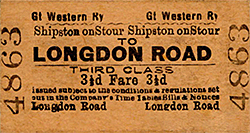 The engine shed was a brick structure to a standard GWR design. It was single road and contained a pit but no other facilities. Coaling of locomotives had to be carried out directly from a wagon. Although the engine shed appears to have been provided from the outset in 1889, there is some suggestion it was a last minute addition. The goods shed is also thought to have been provided at the outset. This was a corrugated iron structure on a brick base, quite common on the GWR, with a two-storey office at its south end, a bay for road vehicles on its west side and internally a platform with the usual 1½ ton capacity hand-operated crane.
The engine shed was a brick structure to a standard GWR design. It was single road and contained a pit but no other facilities. Coaling of locomotives had to be carried out directly from a wagon. Although the engine shed appears to have been provided from the outset in 1889, there is some suggestion it was a last minute addition. The goods shed is also thought to have been provided at the outset. This was a corrugated iron structure on a brick base, quite common on the GWR, with a two-storey office at its south end, a bay for road vehicles on its west side and internally a platform with the usual 1½ ton capacity hand-operated crane.  The passenger station was a simple affair with a platform of about 170 feet in length. The station building was a wooden affair with external framing and would have contained waiting rooms, a ticket office and what the GWR termed a 'cloakroom' which was actually a left luggage and parcels office. There was a lavatory, presumably Gentlemen's, tacked onto the north end of the buildings and a platform canopy was provided supported by iron spandrels. Buildings of this type were more usually used as offices as they were too small and impractical for all but the quietest of railway stations.
The passenger station was a simple affair with a platform of about 170 feet in length. The station building was a wooden affair with external framing and would have contained waiting rooms, a ticket office and what the GWR termed a 'cloakroom' which was actually a left luggage and parcels office. There was a lavatory, presumably Gentlemen's, tacked onto the north end of the buildings and a platform canopy was provided supported by iron spandrels. Buildings of this type were more usually used as offices as they were too small and impractical for all but the quietest of railway stations.stour_old25a.jpg) The terraced cottages on Station Road. Believed to be in the early years of the 20th century but certainly pre 1914. The Stationmaster's accommodation was the cottage on the left, where the two ladies are posing by the gate. By the 1930s it was occupied by a retired Stationmaster. During the same period, Porter Harold Hall lodged with the Peachey family in the third cottage from the left. The fourth cottage from the left was occupied by Mrs Peachey's mother and brother and with them lodged Tom Saunders, an employee of Hutchings, the coal merchant. It is not known who occupied the second cottage. These cottages still exist although that at the far left has been extended towards the road. Cottages further back from the camera, no longer exist. The area, including the site of the station, is now covered by new housing. The ramp in the background behind the group of children, was reputedly provided to allow GWR lorries access to the station platform for the purpose of delivering and collecting parcels and sundries. The station building appears to be well covered by advertisements. The pole on the near end of the building appears in several photographs and was probably a lightning conductor.
The terraced cottages on Station Road. Believed to be in the early years of the 20th century but certainly pre 1914. The Stationmaster's accommodation was the cottage on the left, where the two ladies are posing by the gate. By the 1930s it was occupied by a retired Stationmaster. During the same period, Porter Harold Hall lodged with the Peachey family in the third cottage from the left. The fourth cottage from the left was occupied by Mrs Peachey's mother and brother and with them lodged Tom Saunders, an employee of Hutchings, the coal merchant. It is not known who occupied the second cottage. These cottages still exist although that at the far left has been extended towards the road. Cottages further back from the camera, no longer exist. The area, including the site of the station, is now covered by new housing. The ramp in the background behind the group of children, was reputedly provided to allow GWR lorries access to the station platform for the purpose of delivering and collecting parcels and sundries. The station building appears to be well covered by advertisements. The pole on the near end of the building appears in several photographs and was probably a lightning conductor.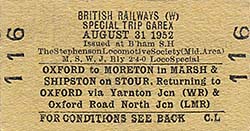 have been provided with gas lighting, though whether this included the interior of the station building is not known. Certainly there was a gas lantern suspended beneath the canopy. While photographs of the station in its early years are not common, let alone clear, it does seem that gas lighting was provided from the outset in 1889 and may also have existed during the later years of the horse tramway (Shipston-on-Stour gasworks dated from 1848). Click here for more information about the gasworks.
have been provided with gas lighting, though whether this included the interior of the station building is not known. Certainly there was a gas lantern suspended beneath the canopy. While photographs of the station in its early years are not common, let alone clear, it does seem that gas lighting was provided from the outset in 1889 and may also have existed during the later years of the horse tramway (Shipston-on-Stour gasworks dated from 1848). Click here for more information about the gasworks.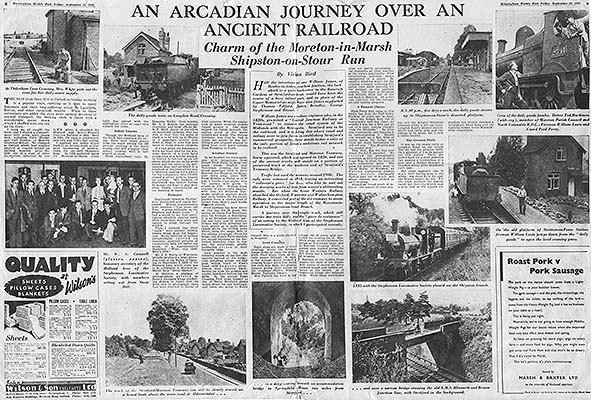 On Friday 12 September 1952, this feature was published by the Birmingham Weekly Post. It included the Stratford & Moreton Railway, (the horse tramway) and the Shipston-on-Stour branch railway. It is really self-explanatory but a few points are worth elaborating upon.
On Friday 12 September 1952, this feature was published by the Birmingham Weekly Post. It included the Stratford & Moreton Railway, (the horse tramway) and the Shipston-on-Stour branch railway. It is really self-explanatory but a few points are worth elaborating upon.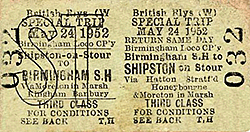 In its final years, the Class K branch goods train 9A62 Down and 9A54 Up ran on Tuesdays and Thursdays only, but it is possible the train was occasionally cancelled as 'Not Required'. It was not however a 'Q' train, a designation for trains running only when required. The majority of traffic during the final years was coal, timber and stone of which the latter was for Warwickshire County Council and of an intermittent nature. Parcels had been catered for by road since withdrawal of the passenger train service, the irony here being that parcels and sundries kept Shipston station going for some three years after all rail traffic ceased
In its final years, the Class K branch goods train 9A62 Down and 9A54 Up ran on Tuesdays and Thursdays only, but it is possible the train was occasionally cancelled as 'Not Required'. It was not however a 'Q' train, a designation for trains running only when required. The majority of traffic during the final years was coal, timber and stone of which the latter was for Warwickshire County Council and of an intermittent nature. Parcels had been catered for by road since withdrawal of the passenger train service, the irony here being that parcels and sundries kept Shipston station going for some three years after all rail traffic ceased 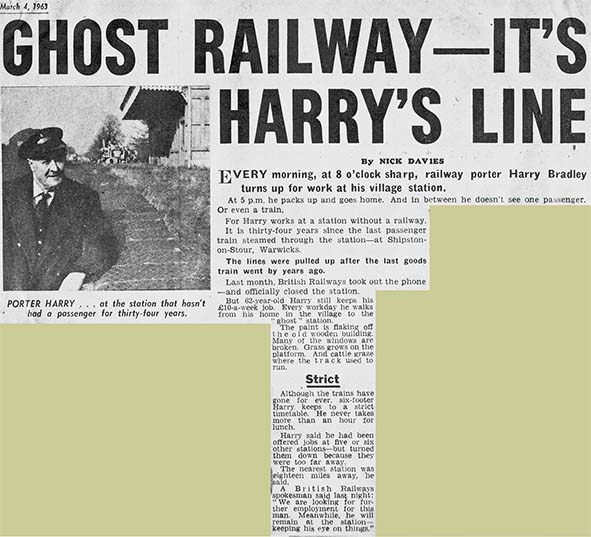 This somewhat romantic article appeared in an unidentified newspaper, possibly the Coventry Evening Telegraph, on the date indicated. The article implies that British Railways closed the station in February 1963, the actual date being 4 February. It is thought Mr Bradley was finally posted to another position elsewhere during May 1963. Whether Mr Bradley really did turn up "every morning at 8 o'clock sharp" after the road service ceased or whether the claim was a mere embellishment for the newspaper article is open to question. British Railways would have required him to turn up in order to justify his wages but, again, whether he did so daily is another matter. Then just as now, the terminology used by reporters who do not necessarily have railway knowledge or any interest in railways, can be quite amusing. Reporter Nick Davies said, for example, "It is thirty-four years since the last passenger train steamed through the station". Given that the station was a terminus it is difficult to see how a train could have 'steamed through' it! Nevertheless such articles can be valuable insights into the past and especially when, as in this case, there is a human part to the story. Most newspapers maintain surprisingly comprehensive archives yet many of their photographs, which are almost always of good quality, are rarely seen unless requested by people undertaking research. Cutting is courtesy of Anthony Hicks. Click
This somewhat romantic article appeared in an unidentified newspaper, possibly the Coventry Evening Telegraph, on the date indicated. The article implies that British Railways closed the station in February 1963, the actual date being 4 February. It is thought Mr Bradley was finally posted to another position elsewhere during May 1963. Whether Mr Bradley really did turn up "every morning at 8 o'clock sharp" after the road service ceased or whether the claim was a mere embellishment for the newspaper article is open to question. British Railways would have required him to turn up in order to justify his wages but, again, whether he did so daily is another matter. Then just as now, the terminology used by reporters who do not necessarily have railway knowledge or any interest in railways, can be quite amusing. Reporter Nick Davies said, for example, "It is thirty-four years since the last passenger train steamed through the station". Given that the station was a terminus it is difficult to see how a train could have 'steamed through' it! Nevertheless such articles can be valuable insights into the past and especially when, as in this case, there is a human part to the story. Most newspapers maintain surprisingly comprehensive archives yet many of their photographs, which are almost always of good quality, are rarely seen unless requested by people undertaking research. Cutting is courtesy of Anthony Hicks. Click 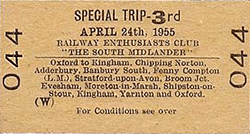 After all rail traffic ceased in 1960, the station was for all intents and purposes left for nature to reclaim. Demolition of the by-then-shabby wooden station building occurred sometime in the mid 1970s while part of the platform along with other buildings survived a little longer. The engine shed was a late survivor and although apparently Listed, or Listing had been applied for, it was ultimately demolished regardless. The Listing, or applied for Listing, was probably Grade 2 which does nothing more than acknowledge existence but adds to the effect that the structure should be saved if possible. It is therefore only Grade 1 Listing that provides any real guarantee of survival. In 2001 the station site was finally cleared of all remaining railway evidence with the exception of the weigh house, visible from the western arm of Station Road, but standing on private property just east of the former gasworks house.
After all rail traffic ceased in 1960, the station was for all intents and purposes left for nature to reclaim. Demolition of the by-then-shabby wooden station building occurred sometime in the mid 1970s while part of the platform along with other buildings survived a little longer. The engine shed was a late survivor and although apparently Listed, or Listing had been applied for, it was ultimately demolished regardless. The Listing, or applied for Listing, was probably Grade 2 which does nothing more than acknowledge existence but adds to the effect that the structure should be saved if possible. It is therefore only Grade 1 Listing that provides any real guarantee of survival. In 2001 the station site was finally cleared of all remaining railway evidence with the exception of the weigh house, visible from the western arm of Station Road, but standing on private property just east of the former gasworks house.
 Home Page
Home Page